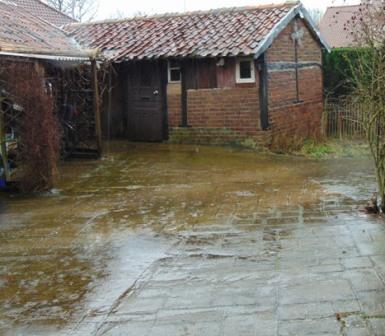Rain, snow and hail are called precipitation. (A nice translation from my mother language would be heaven water).
 Since February 1, 2005, in Belgium you are obliged to install in new and renovated buildings with a horizontal roof area bigger than 75 m² a cistern or rain tank from at least 3,000 liters. Also pavement as driveways, patio and parking can be included(by municipality, county...and other laws).
Since February 1, 2005, in Belgium you are obliged to install in new and renovated buildings with a horizontal roof area bigger than 75 m² a cistern or rain tank from at least 3,000 liters. Also pavement as driveways, patio and parking can be included(by municipality, county...and other laws).
Wastewater and storm water must be drained separately (although there are not everywhere ‘separated’sewer systems provided by the government herself). Too much rainwater dilutes wastewater too much and makes sewage treatment works less.
Storage, buffering, infiltration and use of rainwater is cheaper and more eco friendly than direct discharge and disposal, and use tap water. It is also a (partial) remedy against flooding.
The groundwater level in many places already dropped sharply due to permanent pumping by individuals, industry, agriculture and producers of drinking water. In addition, groundwater is fed less, because there are more paved areas (buildings, driveways, parking lots, roads,...). This causes that rainwater flows away in rivers and urban drainage, rather than infiltrate. This is problematic for sewers, sewage treatment plants and surface waters. During heavy rains floods can occur, followed by shortages and drought that affects flora and fauna in and around the water.
In addition to a separate drainage for rainwater, you also get a second circuit in the house. The filtered water is fed to a well. At the suction point in the tank is a second filter, which prevents clogging of the pump.
You can use the softer rainwater for toilet flushing, watering the garden, animal watering, car washing, cleaning and laundry.
If you only use it for the toilets, you can save 30% on your tap water. Including the cleaning and the laundry you can save more than half.
To capture dust and leaves you place a pre-filter. This can be a fine screen over the intake, with a decline of about 11 cm (50 cm length). Eventually you can make a cascade system where dust and dirt can settle. Make from there an extended, quiet supply (e.g. perforated tubes) so that the water flows into the pit and no sediment swirls up. This also gives a relatively high grade of oxygen in the water giving you optimum quality. To keep the good quality, you save water, just like food, cool and dark, so preferably underground.
An overflow to an infiltration area (or ditch, open water, drainage) protects the well from flooding.
For resisting pests and possible backflow of contaminated water you install check valves. (See also <pump>)
If you're not (re) building you can find on the market barrels for hundreds of liters to place below the gutter to fill with ’heavenly water’. The overflow can be guided in cascade to next barrels. They are on a pedestal, so you can tap water below. Concern here also it is good to use a filter (and a cover) and a cool place in the shade. Your garden and your cattle will appreciate it.
